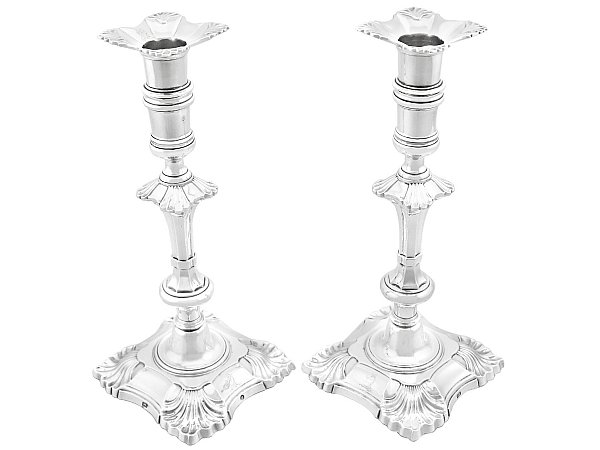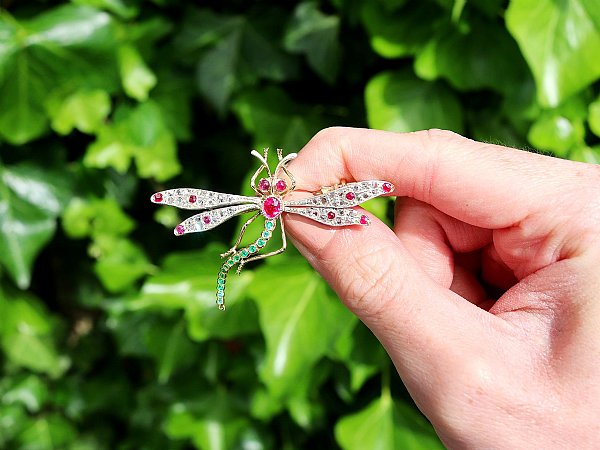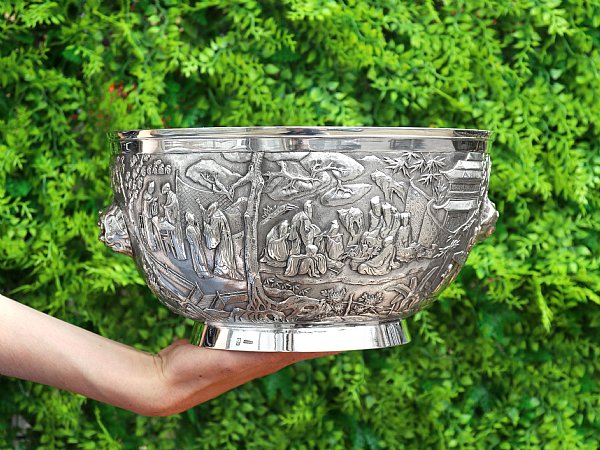Search Results for: '{{searchText}}'
Sorry...
We don't seem to have what you're looking for.
However we do have thousands of magnificent pieces of silver and jewellery available for you to view online. Browse our store using one of these categories.
Please wait for loading data... 
AC Silver is pleased to be able to offer our customers a fine and desirable range of antique Irish silverware for sale.
Our selection of antique Irish silver varies in size and type; from candlesticks, sauceboats and spoons, to condiments and vases.
Andrew Campbell, using his 40 years’experience within the antique industry, handpicks all vintage and antique silver for sale.
All of the Irish silver at AC Silver come with free and insured worldwide shipping and a 14 day return policy.

Although Irish silver and goldsmithing has a 4,000-year history, its golden age is often considered to be between the 8th and 12th century. Dublin acted as a hub of organisation for goldsmiths and silversmiths, raising the standards of the craft over all.
The tradition of Irish Silver dates back to the 13th century, when goldsmiths were first practicing in Dublin. This was the first Irish city that established a guild/company (1498) and a town mark. In 1605, hallmarks first started appearing on Irish silver plate. Dublin plate would be branded with the town mark (a crowned harp) and a maker’s mark.
Upon the reign of Charles I, a new standard was declared that governed Irish silver. This rule stated that no Irish silver could be of a lesser fineness than that of English silver- controlling the quality of plate that Ireland produced. A further law established in 1729 ensured that hallmarks were added to Irish plate. This law stated that silver must be assayed by an assay master. Furthermore, it must incorporate hallmarks, a maker’s mark, the date letter and the crowned harp.
A year later, in 1730, a fourth stamp was introduced. This mark was the ‘figure of Hibernia’. Hibernia is the female natural personification used to represent Ireland (equivalent to Britain’s ‘Britannia’). This mark was added by order of the Commissioners of Excise to assure that duty had been paid.
Yet another change to the Irish hallmarking process occurred in 1807. This was during the reign of George III. At this time, it was decided that the sovereign''s head must be stamped on all silver as a duty mark. This tradition was enforced up until 1890. A lot of the best extant pieces of Irish silver date from the first half of this era, created by makers like Bolton, Hamilton, Walker, and Williamson.
The Dublin Assay office is the only remaining assay office in Ireland today. It was first established in 1637, when it supervised the assaying of gold and silver throughout the Kingdom of Ireland. Up until 1806, silver crafted in Dublin could be identified by its town mark: a crowned harp.
Prior to 1923, Dublin had to comply with the same silver marking laws which governed England and Scotland. Upon the formation of the Free State (1922), however, the laws regarding silver production were governed from within Dublin. Despite the change of order, hallmarks remained mainly unchanged over this transition. Since 1963, the town mark for Dublin has been a solitary harp.
The assay office in Cork never had an established date letter. Prior to 1715, a town mark was used in the production of Cork silver. Pieces would be branded with the city arms: a ship in full sail between two castles (sometimes also including a heraldic icon). After 1715, however, Cork silver was marked only with the maker’s initials, the word STERLING (sometimes corrupted to stirling, starling, sterlin, starlin or ster), and the word DOLLAR (used in place of a town mark). The origin of the latter mark was from ‘doolar’, which signifies that the silver was used for plate. This word was chosen because most silver used for plate came from melted down Spanish silver dollars.
Other assay offices include Limerick, which was established in the 17th century and marked its silver with the fleur de lis. Established during the same century, the Youghal office used the town mark of a masted ship. Similarly to Dublin, the assay office of New Geneva used the mark of a harp. This small village near Waterford was named as a result of the community of Genevan watch makers who chose to settle there.
Clonmel, Waterford, Mullinger, Kinsale, Kilkenny and Drogheda all made plate, which was assayed at Dublin.
Distinct features were commonplace in Irish silver by the mid-1700s. Rustic Rococo themes involving pastoral, rural scenes helped to signify Irish silver. There were also helmet-shaped cream jugs and sugar bowls that were created in Ireland more so than across Europe. Perhaps the peak of Irish silversmithing is the dish ring. Sometimes known as a potato ring, these pieces keep hot dishes away from table surfaces.
Travelling with assay-marked silver in 18th century Ireland was dangerous, as thievery was a likely occurrence. Each piece of assay-marked silver also incurred a duty of sixpence, which could build up very easily. For these reasons, properly hallmarked items of silver were the exception rather than the rule in Ireland at this time.
As early as 1710, silversmiths in areas like Cork and Limerick were stamping their wares with the word’s ‘sterling’ rather than the crowned harp of the Dublin assay office. Others only used makers’ marks, also bypassing assay marks that were technically required of them.
The Act of Union in 1800 made it cheaper to import silver from Sheffield and Birmingham, rather than trying to target legislature towards the duty-dodging Irish silversmiths. As is to be expected, this eventually led to the death of the Irish silversmiths. In 1853, the last silversmith left Cork, destined for Australia, though tragically he drowned in the journey.
Similarly, to provincial silversmiths in other countries, Irish provincial silversmiths’ lack of assay marking does not equal a lack of quality in their items. Contemporary analysis suggests that – on average – Cork wares from this period are more compliant to the sterling standard than those from Dublin.
In present day, somewhat predictably, wares from Cork are far scarcer than any silver items from Dublin. Pieces originating from other provincial areas such as Limerick are counted in their tens, rather than their hundreds or thousands. This rarity does create a significant appeal for those collecting provincial items, however. Having an item that no-one else possesses generates an exclusivity that is very alluring to collectors generally.
Another aspect of provincial Irish silver that makes it an attractive collectable is its unique styles. While many of the pieces were clearly influenced by broader European styles of the time – although maybe slightly behind the most fashionable trends – the Irish silversmiths brought their own flair to their creations, and they rarely just copied popular pieces directly.
Due to their contemporary popularity, fakery is often inspired by these pieces. If it becomes too commonplace, this fakery can actually bring the price of an item down. Another issue that provincial Irish silver faces is the practise of removing certain design aspects to make the items more in-line with popular styles. This mostly happened in the Victorian period, where removing designs from English silver items was usually too expensive, but often the expense was worth it if the pieces used were the – already less valuable – provincial Irish pieces.
Today, provincial Irish silver is still a valued collectable, but it generally holds less value than Irish pieces with well-known makers and official assay office hallmarks, such as those pieces from Dublin.
In 1555 the Dublin goldsmiths were granted a Charter, with a Royal Charter to come in 1637 – this saw the mark we recognise today of the sterling standard harp, replacing the unenforced lion, harp and castle. From 1638 the date letter system began; however, this was a haphazard method and when the Hibernia duty mark came about in 1730, many omitted the date letter from the article.
The Hibernia mark is often mistaken for a Britannia standard mark found on English silver but as with Scotland, there was no era of Britannia silver in Ireland. The Hibernia mark was intended as a duty mark, however in 1806 Irish silver was struck with the king’s head duty mark as well, causing the Hibernia mark to be displayed as the Dublin Assay Office mark.
Whilst there were no assay offices authorised outside of Dublin (except for a watch case assay office in Waterford, which was never utilised) there were some guilds in provincial cities. The majority of the records from Cork were lost in a fire at the Courthouse in 1891 – the names and marks of many goldsmiths are known from the middle of the 17th century to the beginning of the 19th century.
For items stamped with their own name punch, it is often accompanied by the castle and ship mark, along with the written word ’Sterling’ or ‘Starling’.
In the late 17th century to the beginning of the 18th century Limerick also used a castle mark, Galway and Youghal dedicated a mark to their maritime connections with a ship mark (Youghal) and an anchor (Galway).
Identification of silversmiths from 1637 onwards is possible due to the full and extensive lists registered with the Dublin Goldsmiths’ Company. From 1784, the provincial Irish silversmiths were also registered with Dublin Assay Office, in addition to being identified through the local records of Cork, Youghal, Galway and Limerick.




